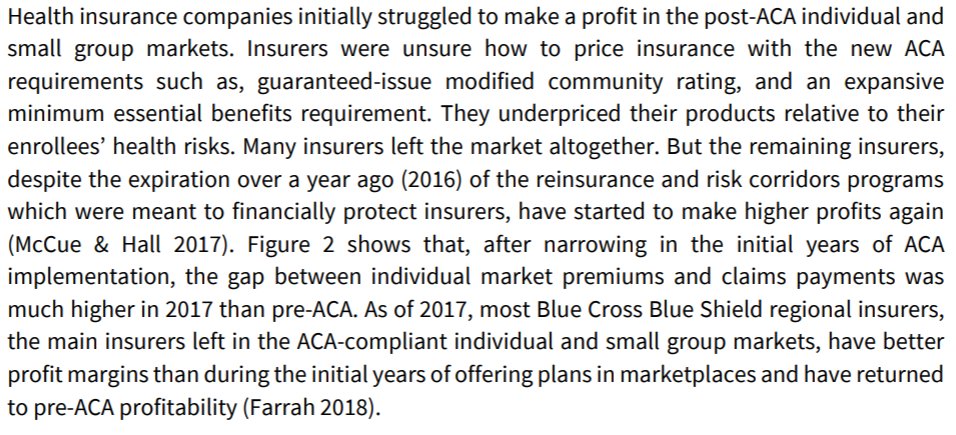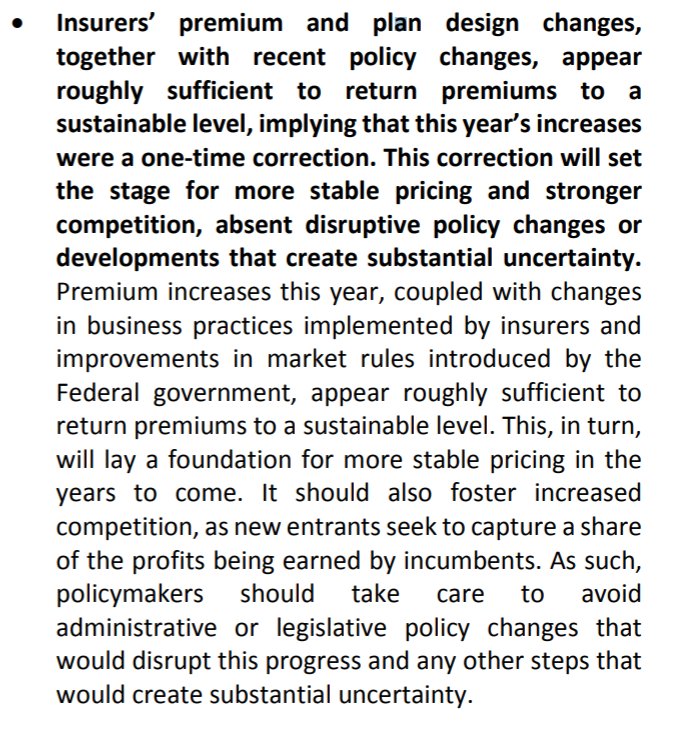CBP Agents have no business doing Credible Fear Interviews.
nyti.ms/2JqLKig
And why aren't they? Why don't they just hire more Asylum Officers?
Even one of the Senior Border Patrol Officials rightfully protested, "I don't want to be Judge Dredd."
cnn.com/2019/05/08/pol…
Which is, of course, the entire point.
reuters.com/article/us-usa…
For one, no one knows if this is what will be used to train up the CBP Asylum "experts."
*after lunch
tmsnrt.rs/2VJPtOk
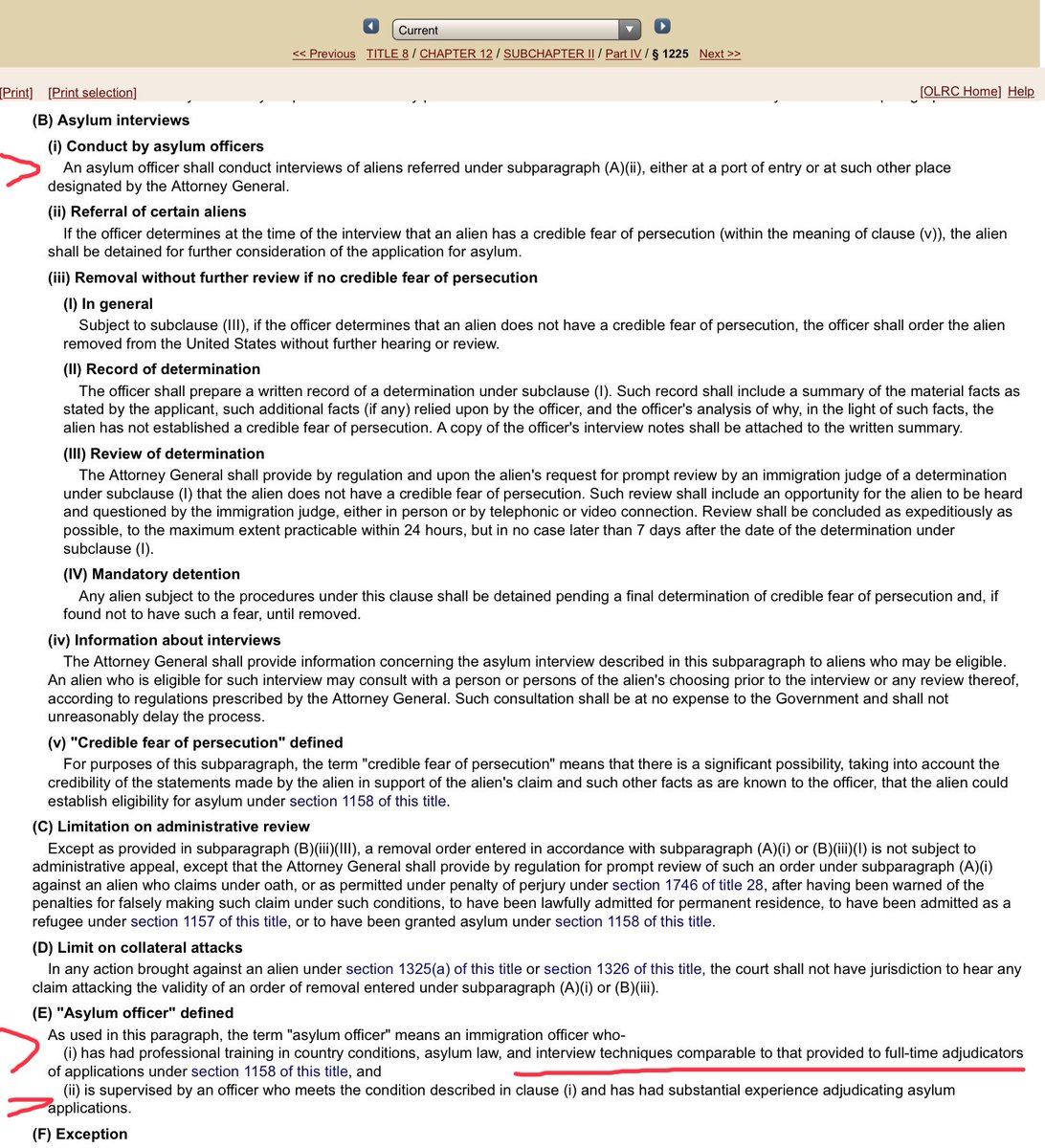
So let's just do this before I fry!

There's no indication on how long this class lasts--1 day? A week? Two? It's gonna be a REALLY important part of the job of the Asylum Officer, so one hopes it's comprehensive.
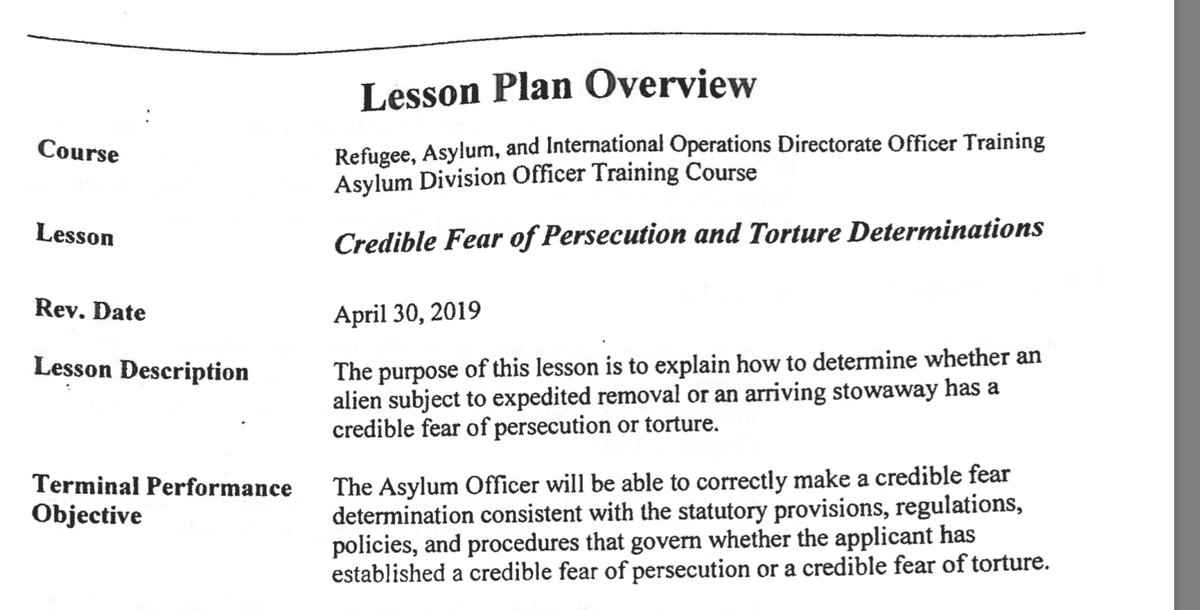
Also note: special training sessions on working with kids, women and those who might've been trafficked.
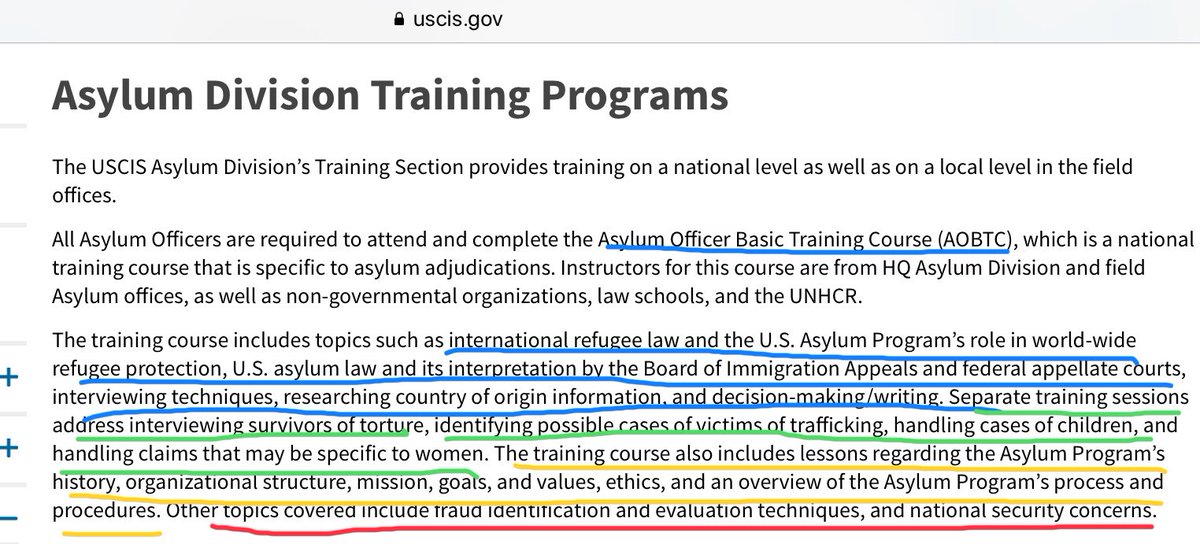

My suspicion is immediately raised bc while the "purpose" is to suss out if someone's Fear is Credible or no, according to a whole series of rules ®ulations, there's nothing in the Performance Objectives or Critical Tasks about learning to do an interview.
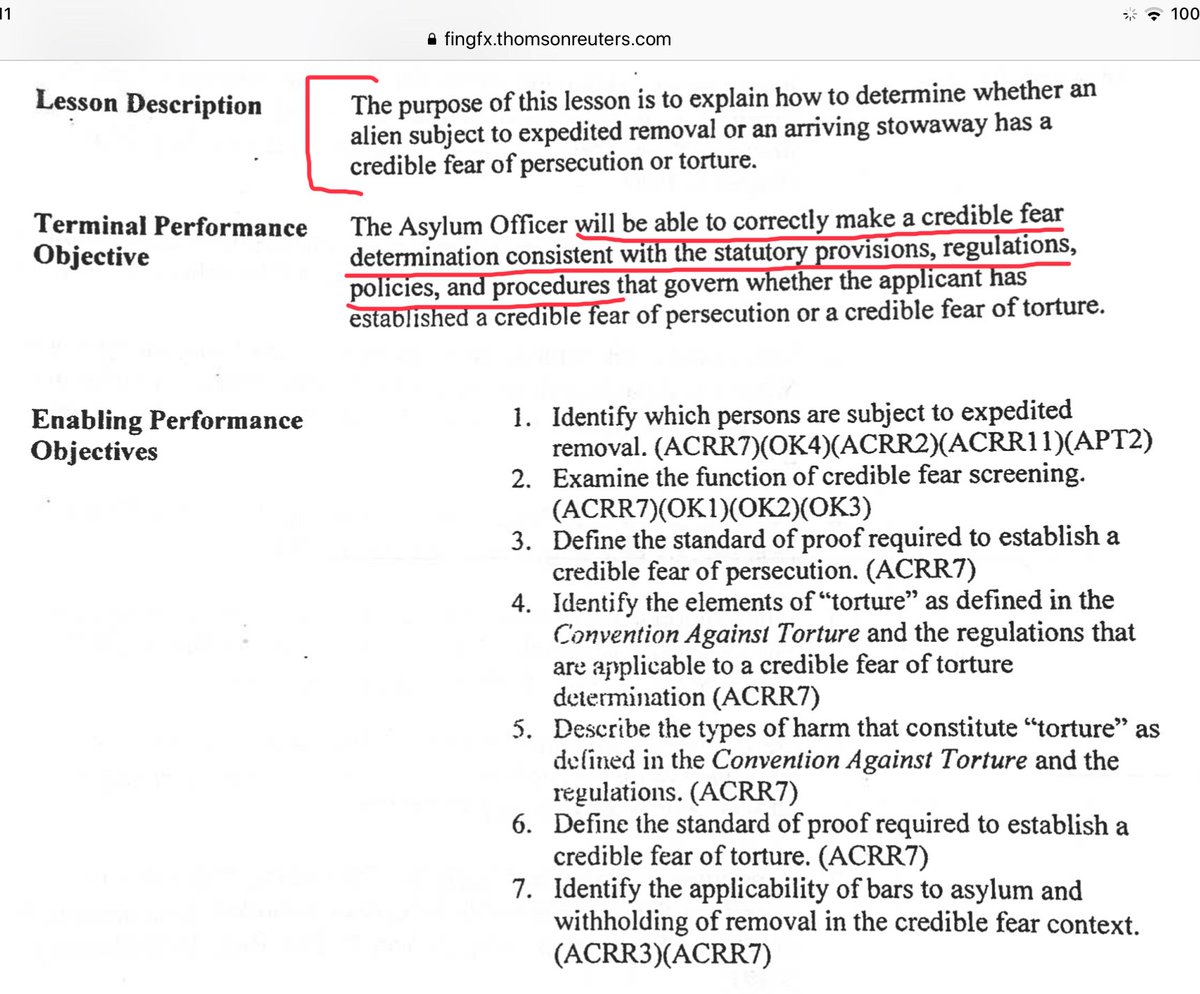
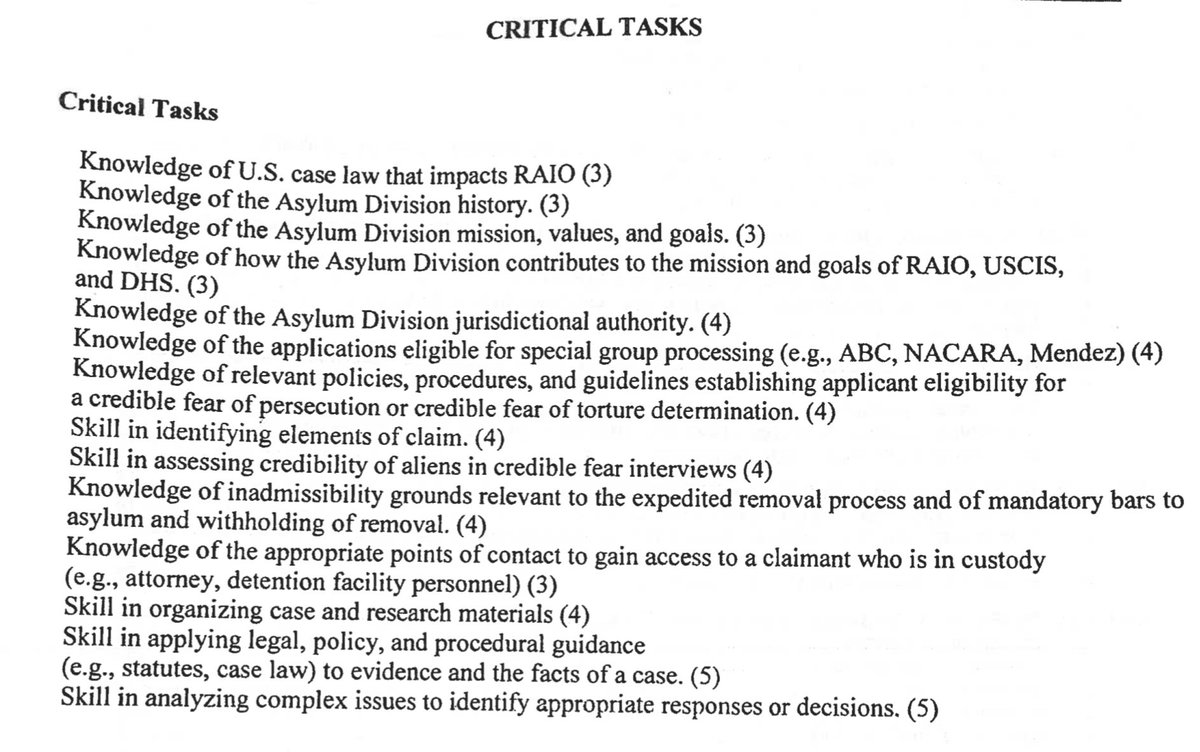
The 1st few pages mostly deal with determining who's eligible for expedited vs non-expedited removal & what that means exactly, and there's a recent case that AG Barr referred to himself that muddied the waters enough that it's all very confusing.
Onward!
Section III - Function of a Credible Fear Screening
We're off to a great start, with the function described as a way to get rid of those pesky false claims lickity-split, oh, and let the possibly real ones through, too, sure.

This is where shït gets infuriating. Cuz where usually, the standard is for the person requesting asylum to express a CREDIBLE FEAR of returning home that's then explored in court later...
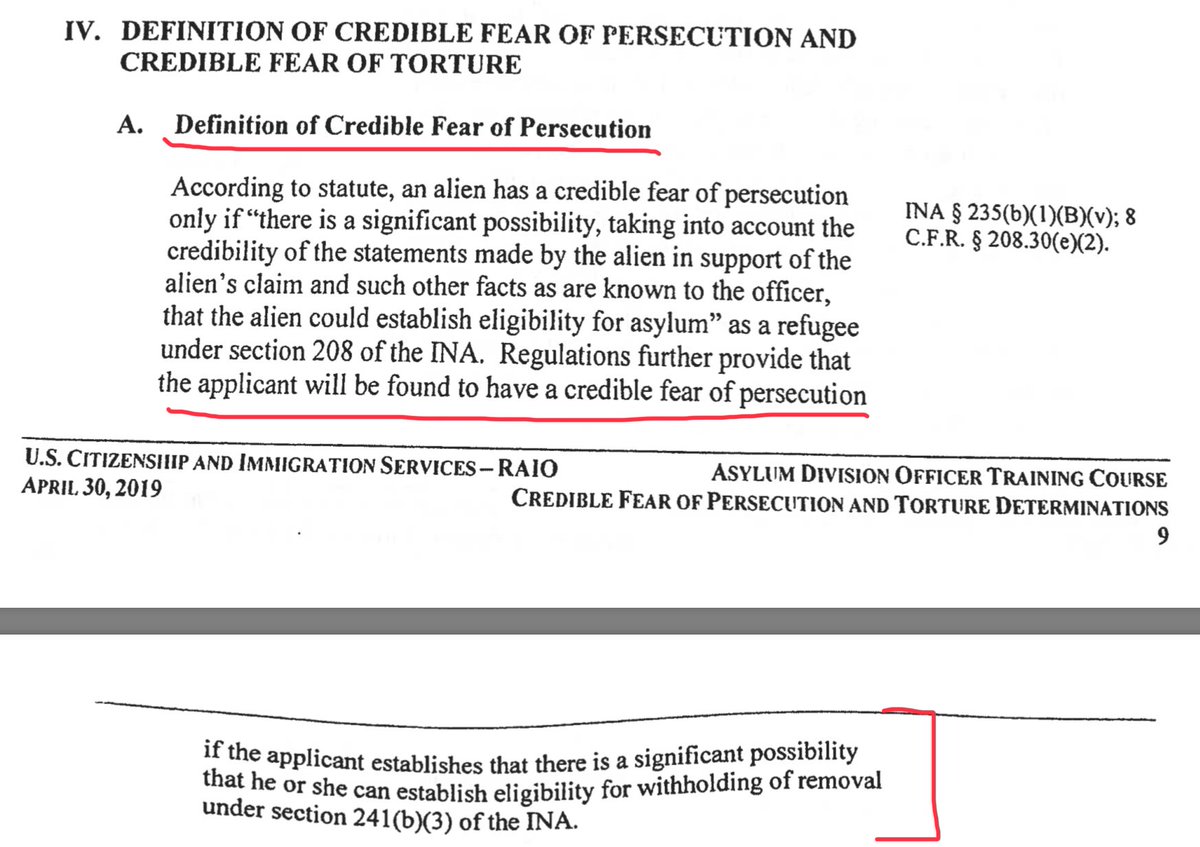
Look...
1. Just that statement in part A above, that "...credible fear of persecution only if 'there is a significant possibility...[they] could establish eligibility for asylum...'" is nuts!
3. Section V pretty much proves it, though.
A. This is where I went searching in vain for an hour, only to realize the blue underlined 340 is a page # and not another AG self-referred decision. 🤦🏻♀️

In last year's decision, proof had to be given to the AO, immigration judge OR BIA.


Was it worth the hour I wandered the wasteland to point this out? Maybe.
In case you don't remember, here's the matter Sessions referred to himself. The one about domestic violence that got overturned in Dec & the DoJ is appealing.
aila.org/File/DownloadE…
"Non-adversarial manner" indeed.
That's hard enough when you're talking to traumatized people, often not in their native language (how many AOs know Qechi?) when they don't know what happens next.

slate.com/news-and-polit…
.
.
.
Where are your children anyway? Are they with you? Or have they been removed? How does that affect your ability to relate the details of your trauma?
apa.org/news/apa/2018/…
It's got to be airtight, apparently. "Credible," "persuasive" and contain "specific [somehow verifiable?] facts."
This is the initial interview, mind you.
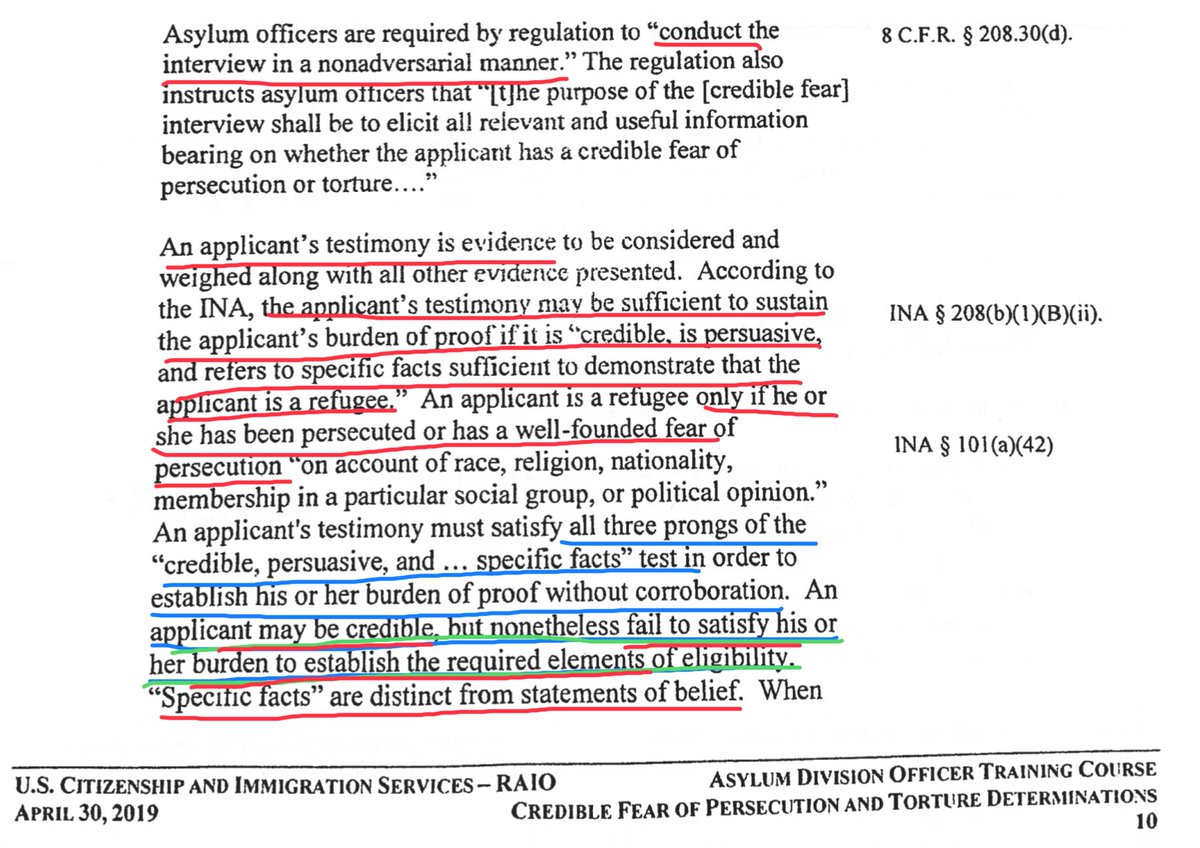
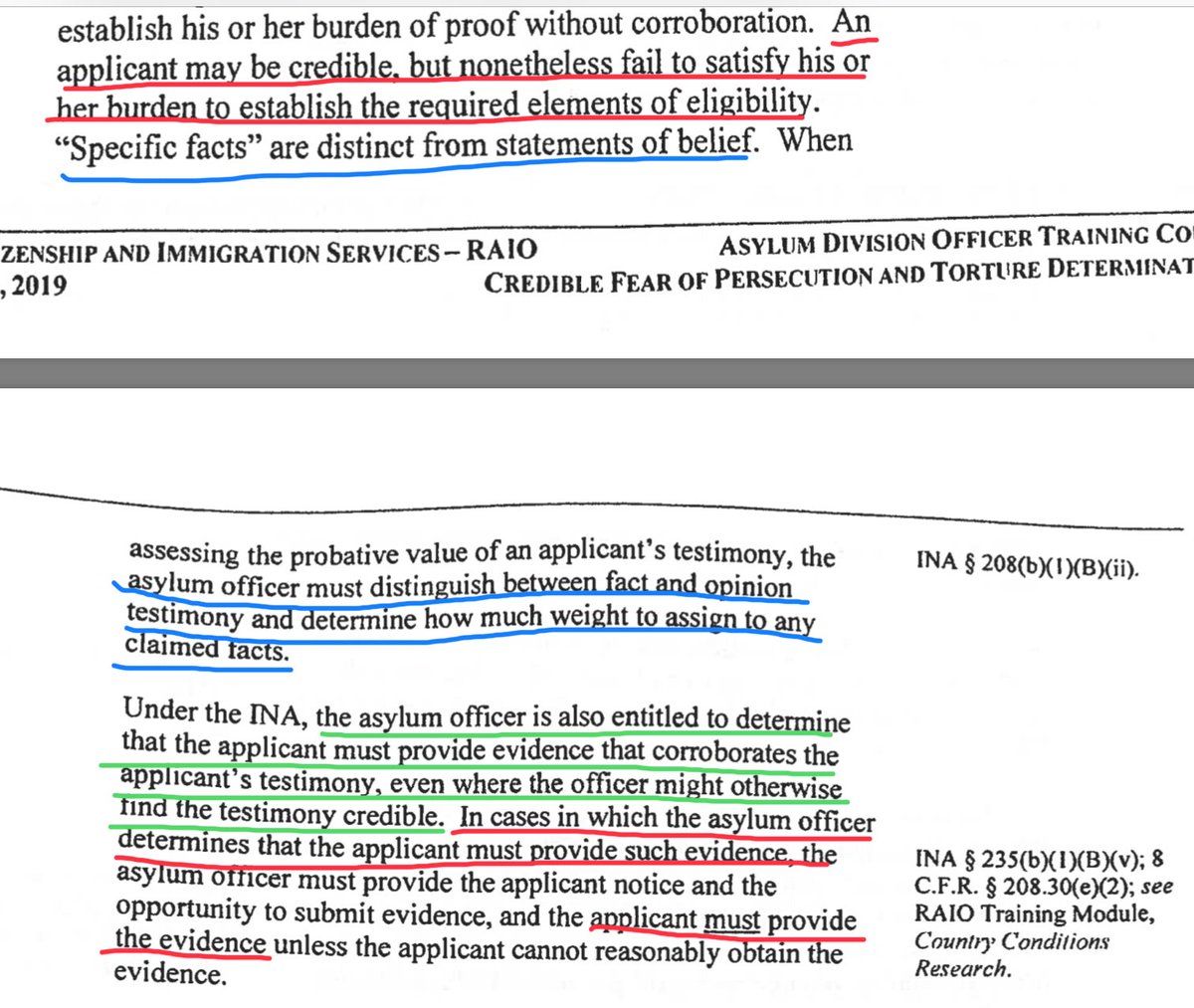
You must recognize it by now.
Nothing in there about evidence for the AO. The opposite, in fact.
It says STATEMENTS, USCIS!

In addition to the refugee's STATEMENTS, the AO MUST take into account other relevant facts, such as country conditions, when making a credible fear determination. This info about country conditions can come from many sources, including news agencies, international orgs.
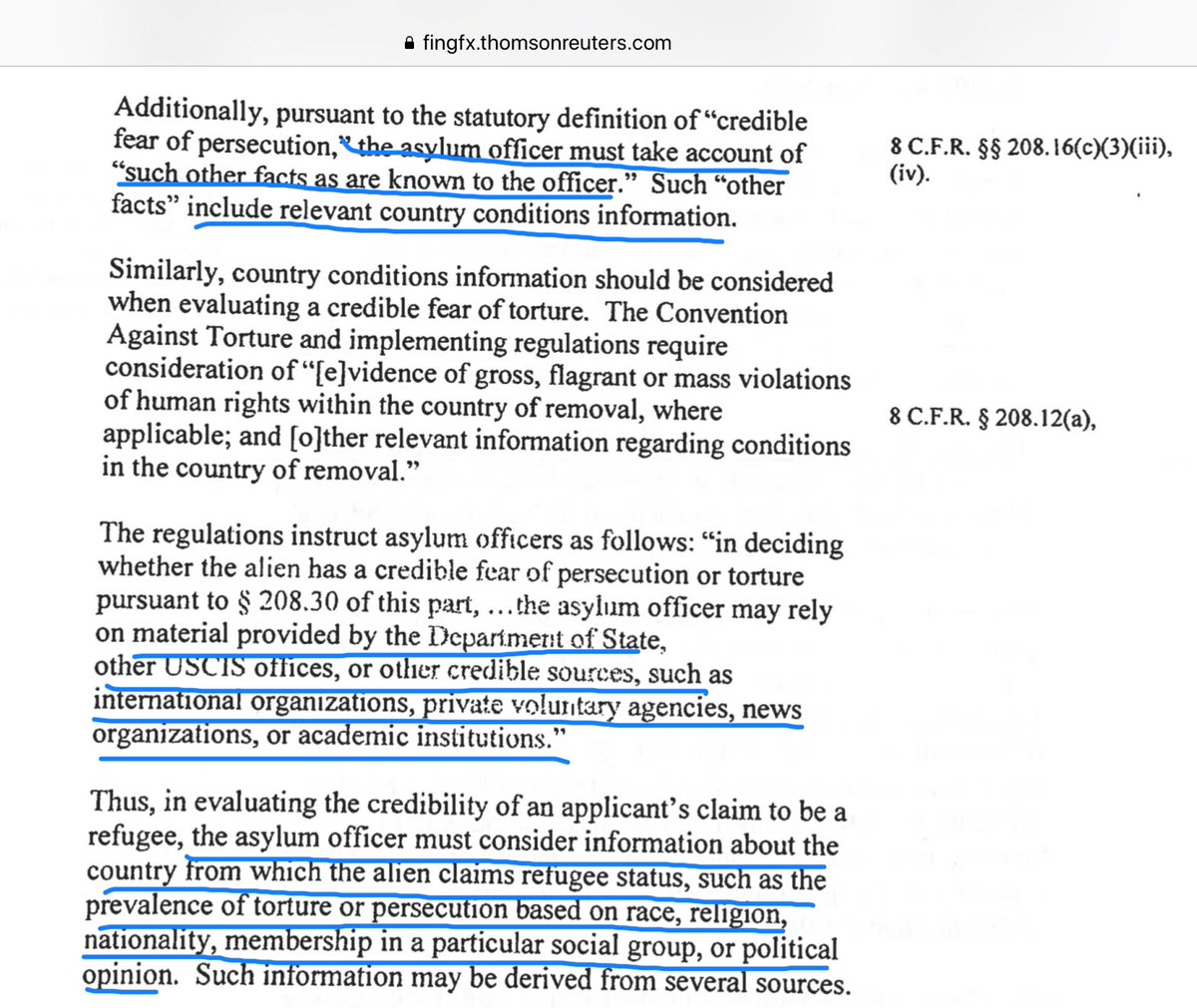
UN Human Rights Report on Violence Against Women in Central America:
unhcr.org/56fc31864.pdf
Not a "mere possibility." Not a "minimal possibility," but a "significant possibility." There is, apparently, no middle ground, like, "pretty good possibility."
A "significant possibility" requires MORE than "significant evidence."
Obviously.
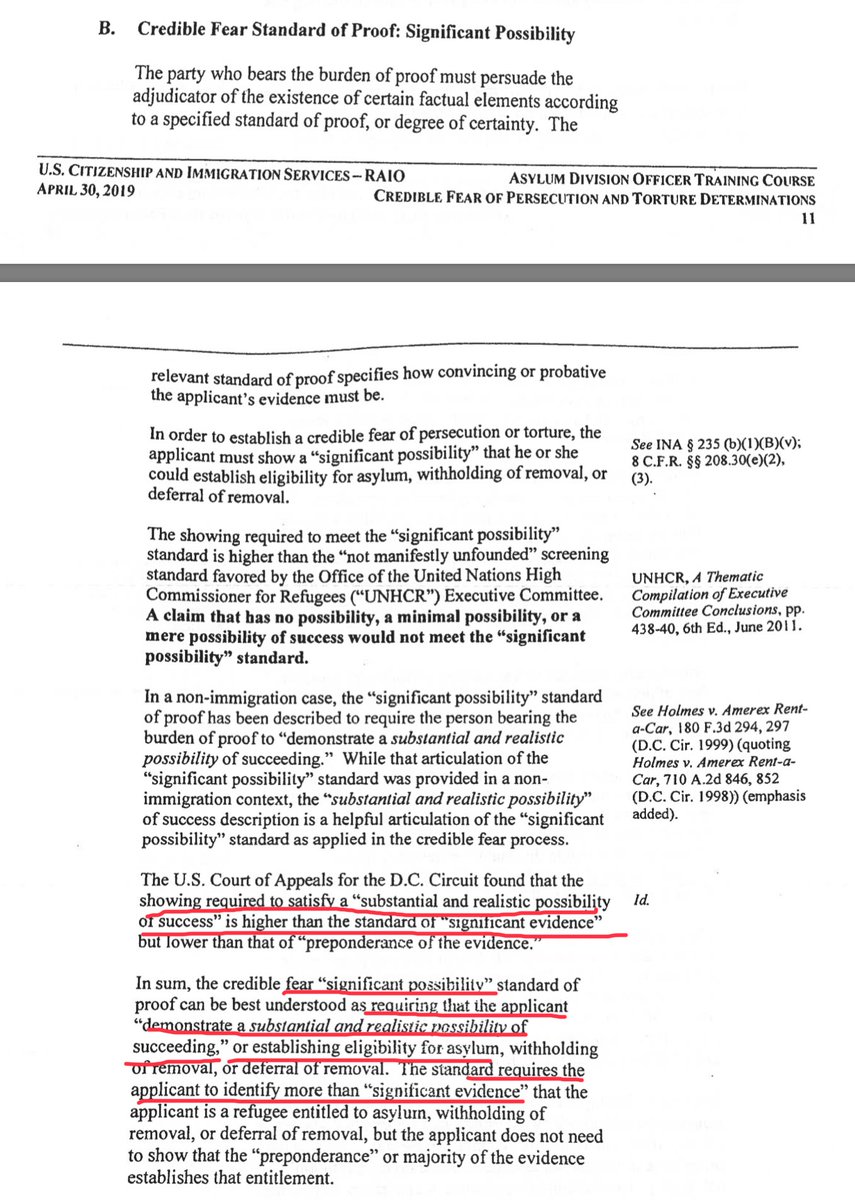
What, really, is credibility? What does USCIS think it is? They're likely two very different things. But this "course outline" or whatever takes a valiant whack at it nonetheless.
AOs are meant to make a determination after ALL facts have been elicited...
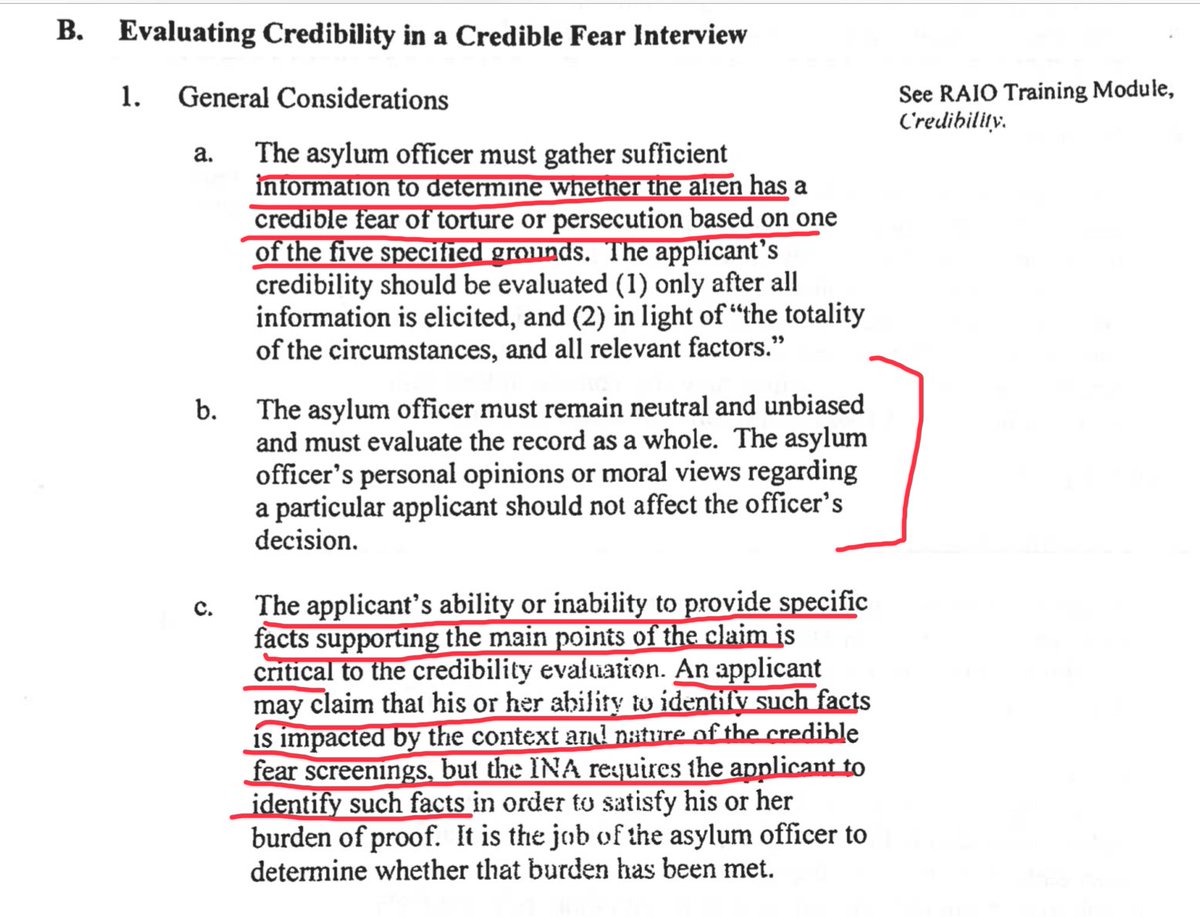
teenvogue.com/story/border-p…
Set up to fail ✅
Check for internal consistency--did they say something differently to your buddy Jim who arrested them?
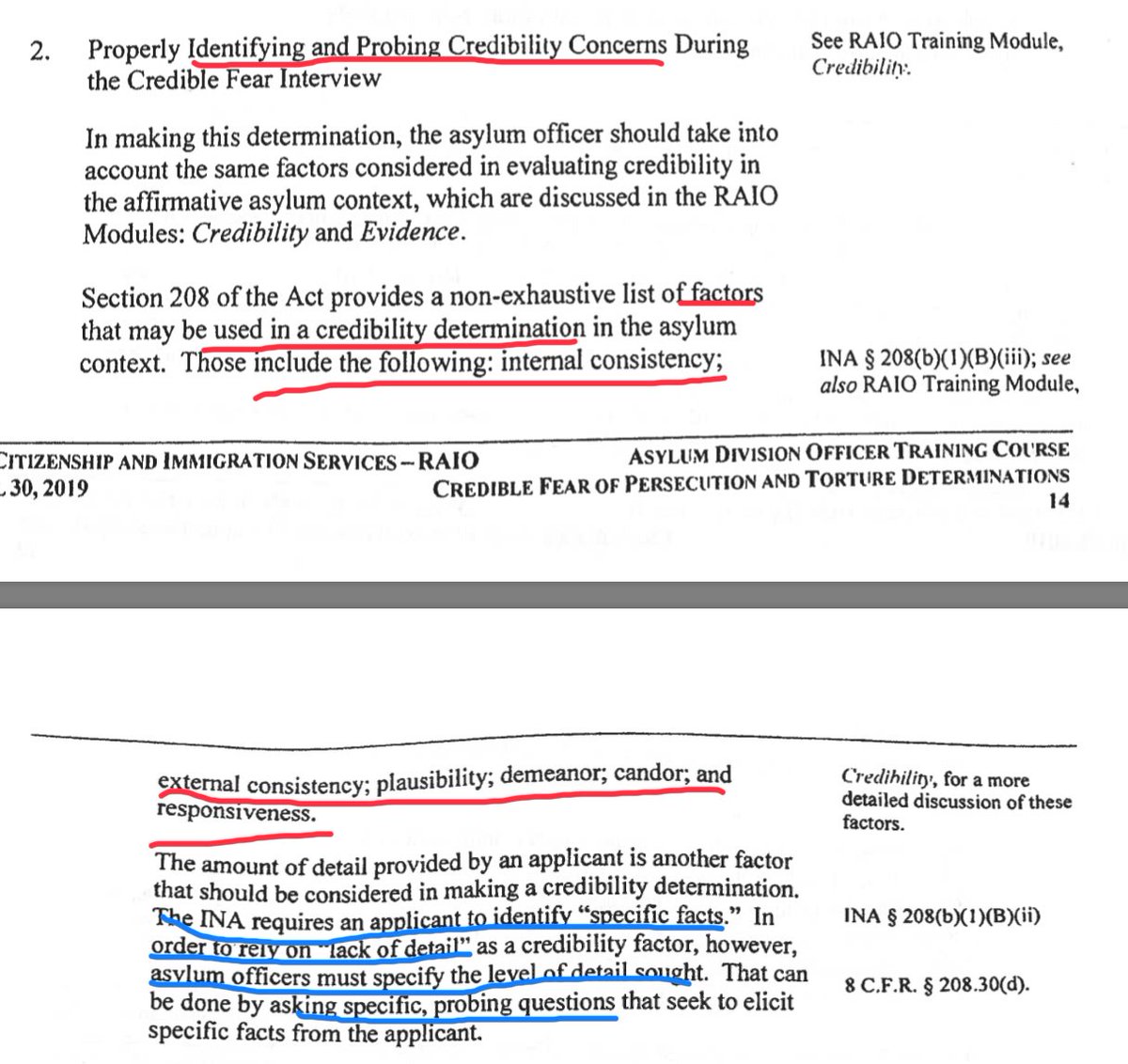
Plausibility--Their whole family was killed? And they were raped? Four times? Sure. 🙄
Candor--And why did I have to ask half a dozen times before they told me about the rapes, huh?
Responsiveness--Now they're just shutting down and won't answer any questions. Guess they really don't want to be here.....
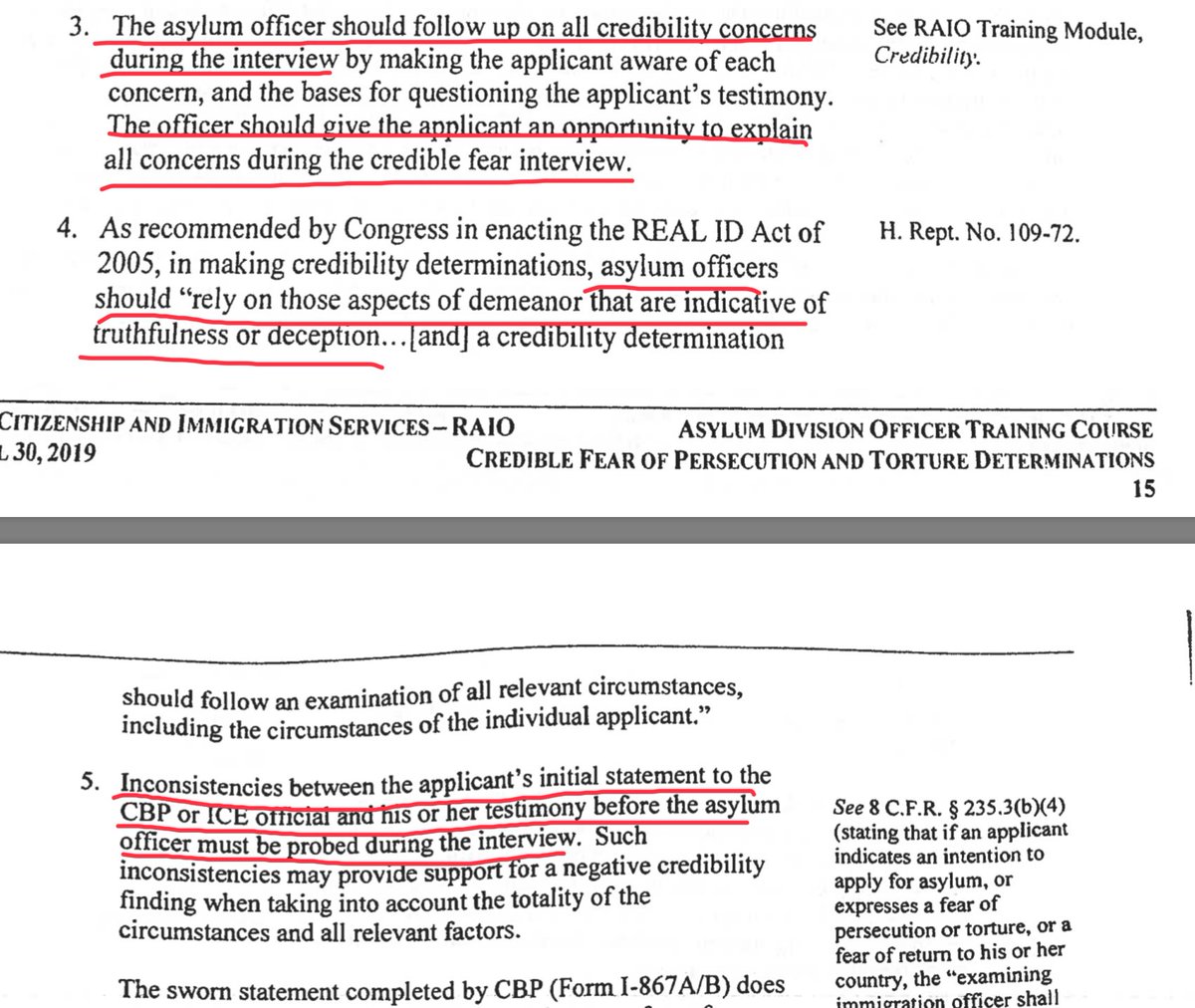
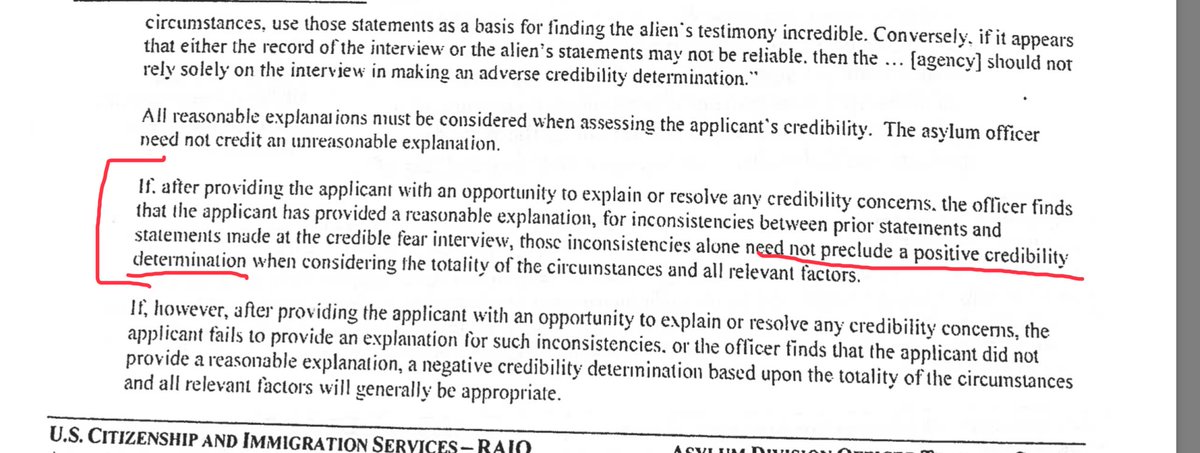
VII - Establishing A Credible Fear of Persecution
Requires Refugee proving 3 things:
1) That they've been harmed
2) That things haven't changed--they'll be harmed again
3) Relocating w/in country won't help
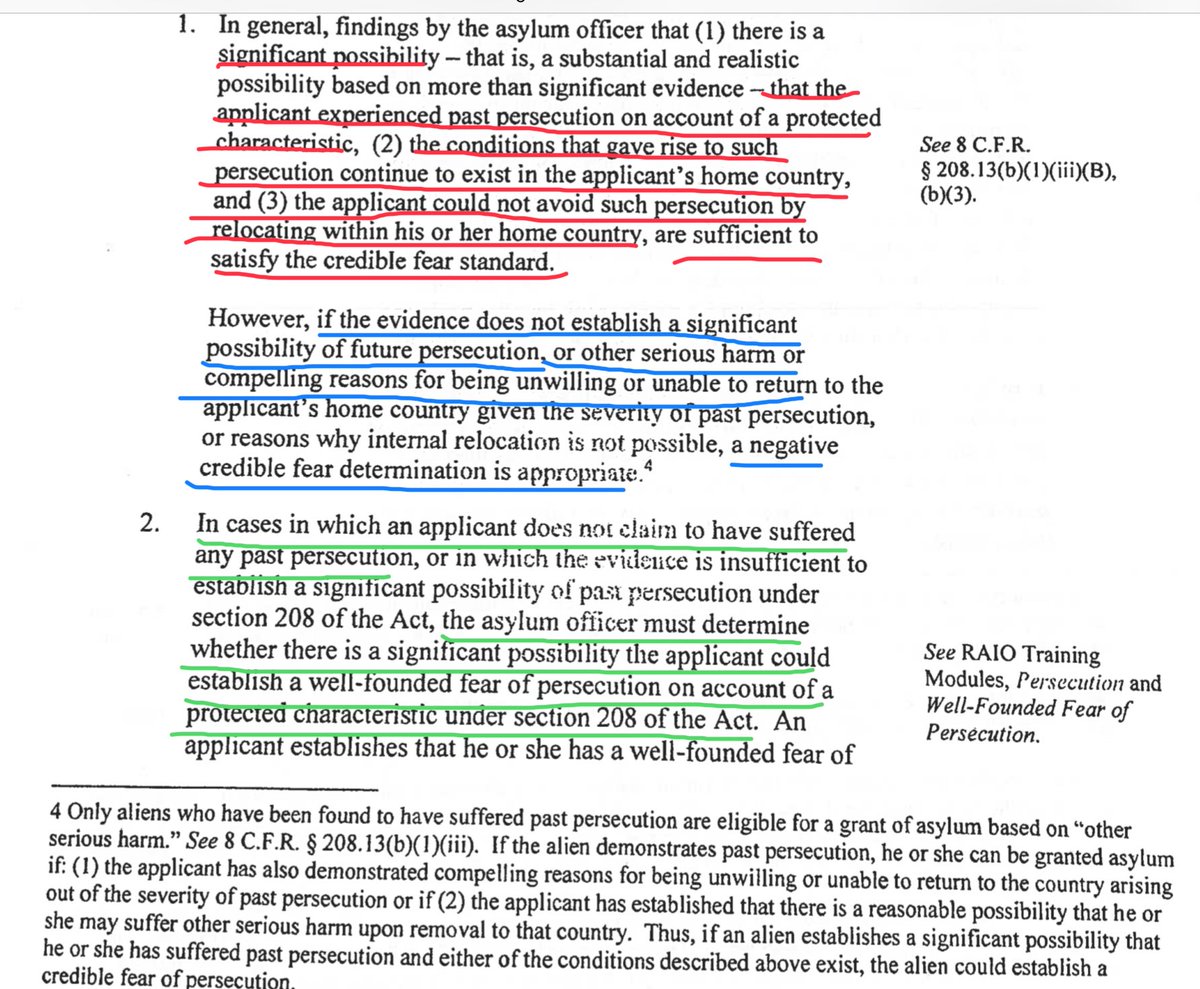
Good question, readers, & tbh, USCIS doesn't know the answer. Oh, they TRY & educated their young AO padawans, but it's doomed to failure for one simple reason:
This manual dances rilly rilly hard around that basic fact, even uses INS vs Cardoza-Fonseca (1987) as a reference (which I just read, fam: see how much I love you!), which held that "well-founded fear" is different from a "more likely than not" standard...
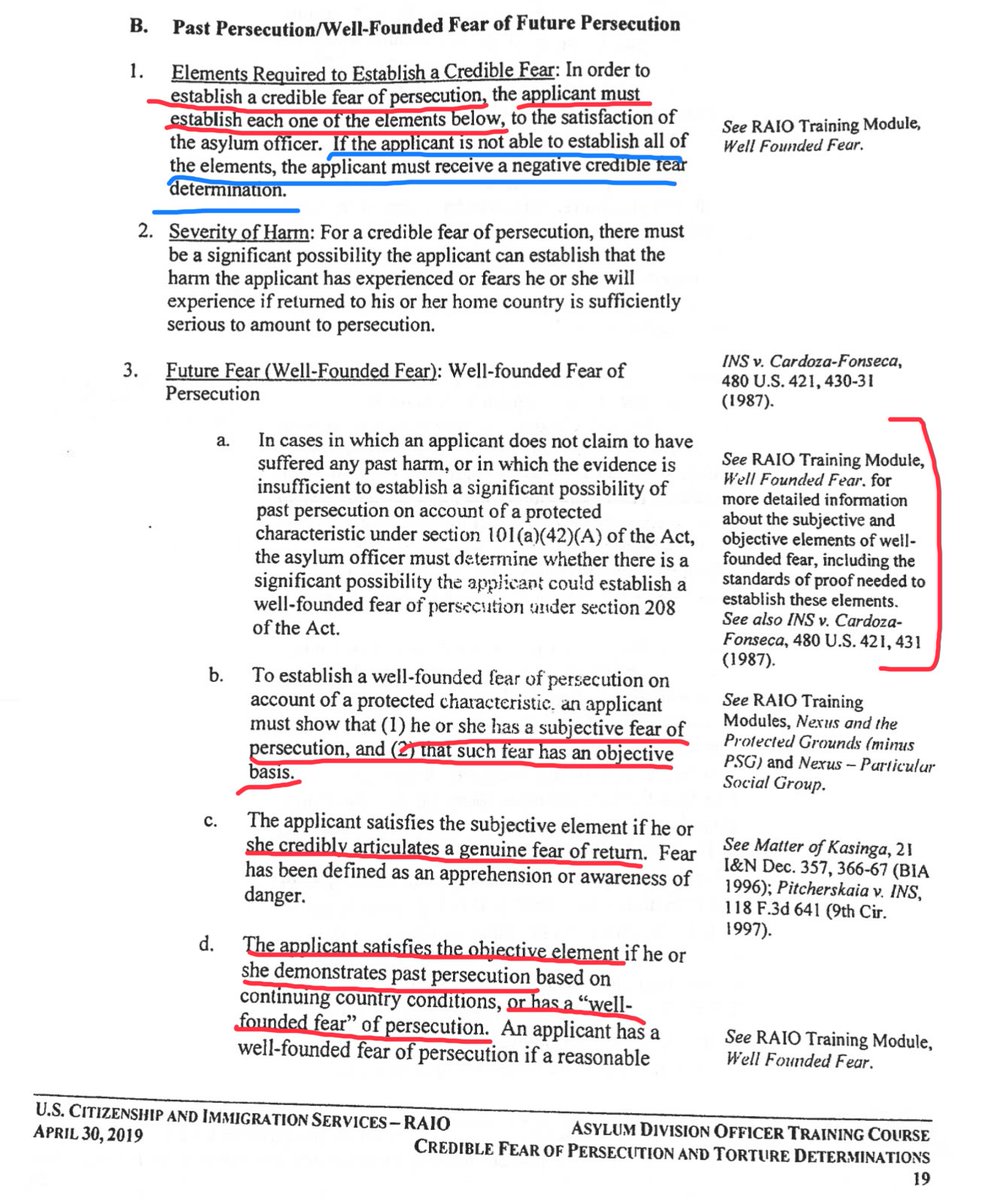
But the manual some drags this along, beating the dead case for three pages...
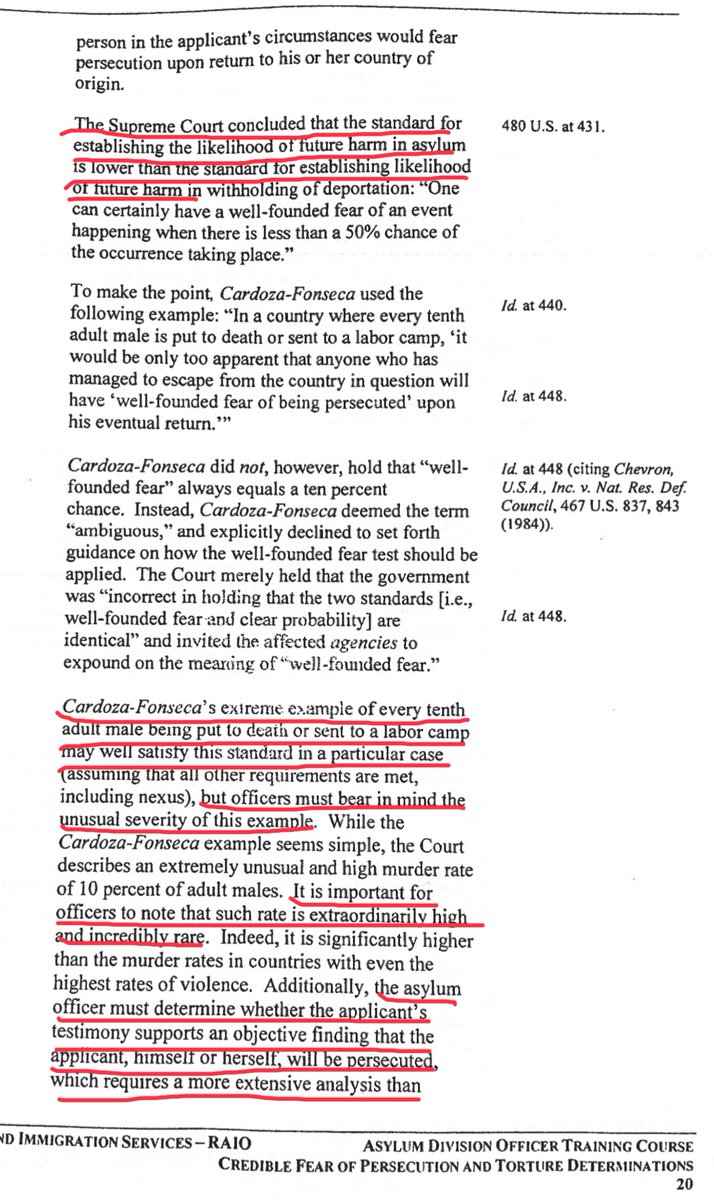
BUT ONLY IF TOTALLY BACKED UP BY FACTS!
Okay, guys, we get it. Objectivity is totally your watchword. 🙄
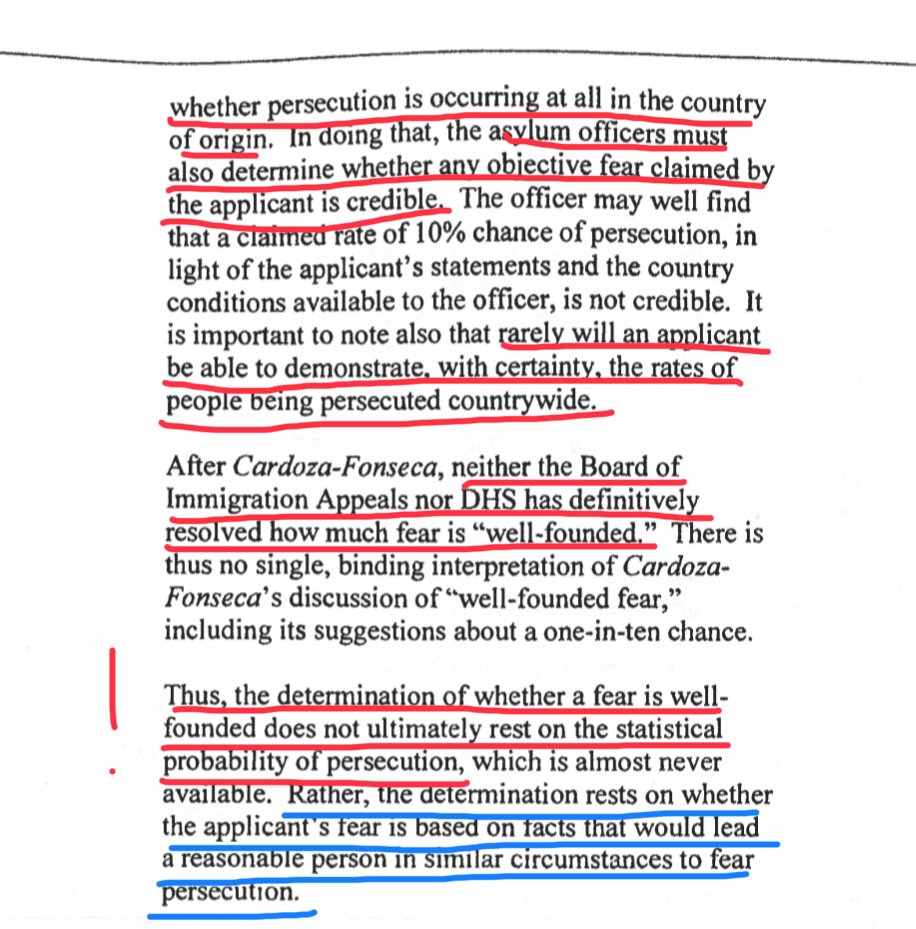
Or, at least, needs to prove the motives of whomever has been or will be persecuting them. I love this game!
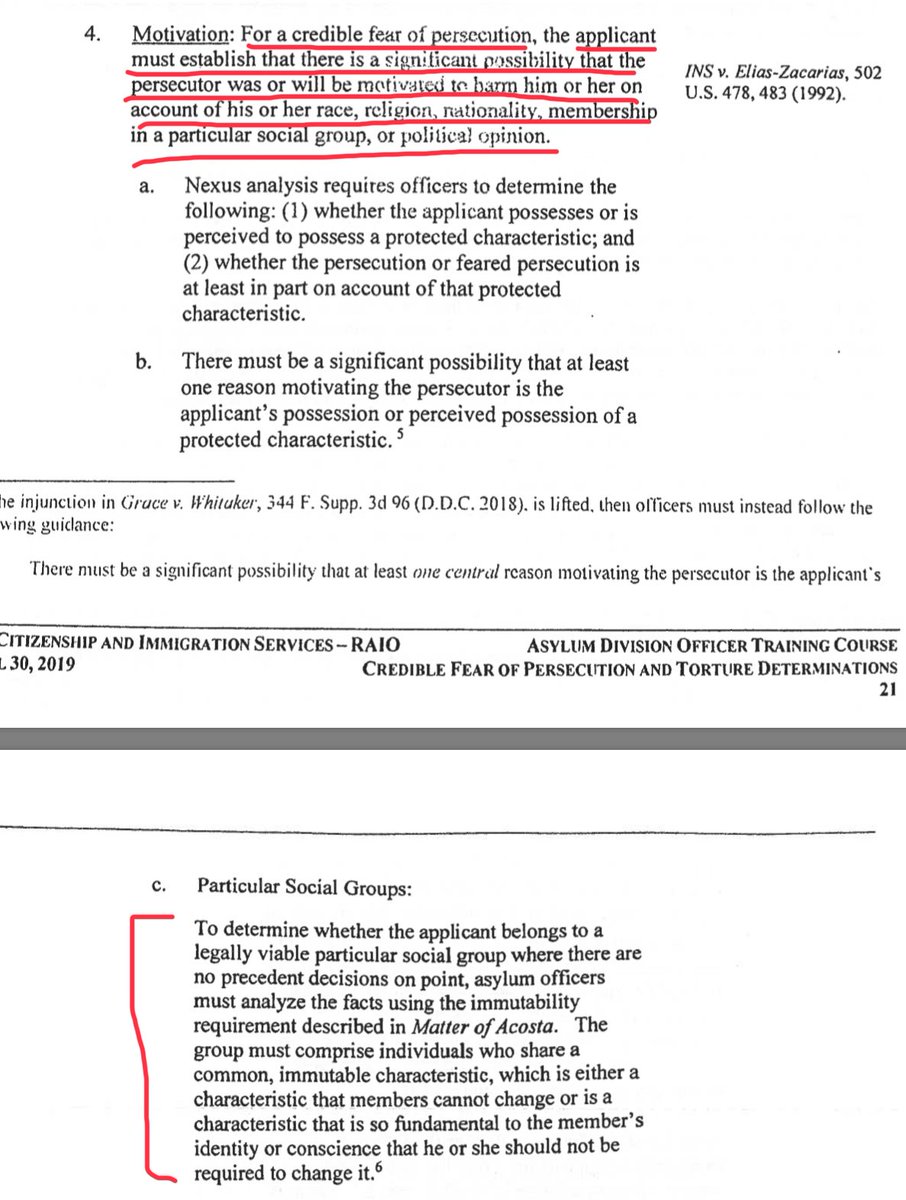

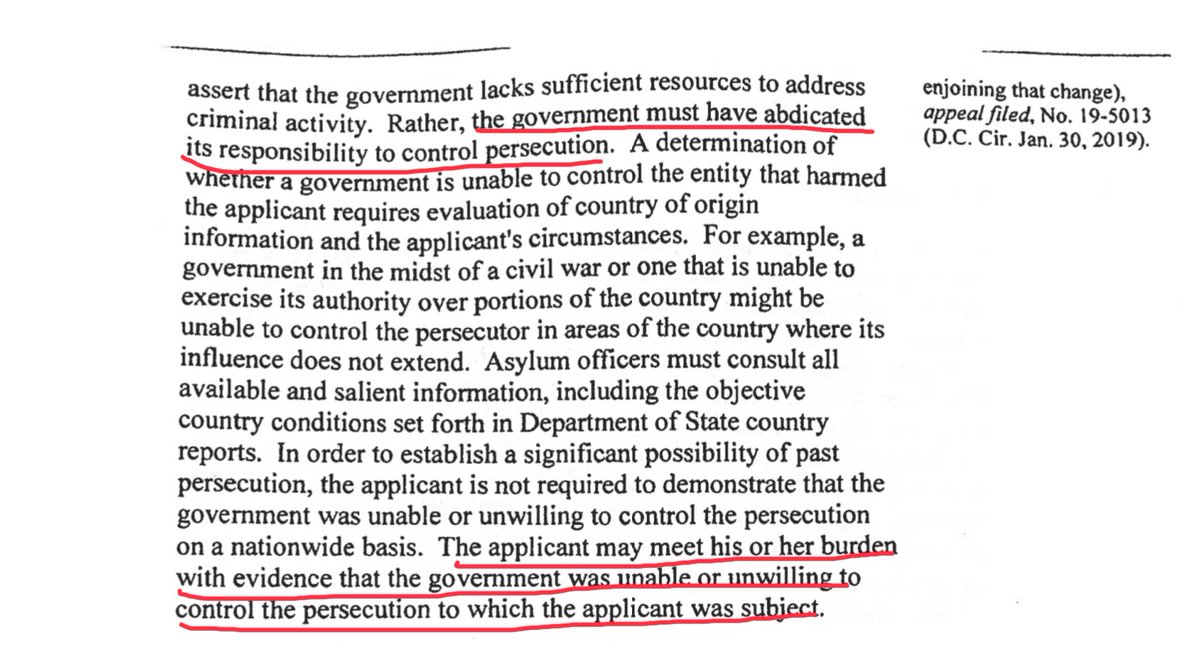
abcnews.go.com/International/…
nytimes.com/interactive/20…
Next point: a) Did you stay in your country too long? Then you obviously weren't afraid enough!
b) At least they're honest enough to admit there are actual real reasons why people don't leave the 1st second after something bad happens.
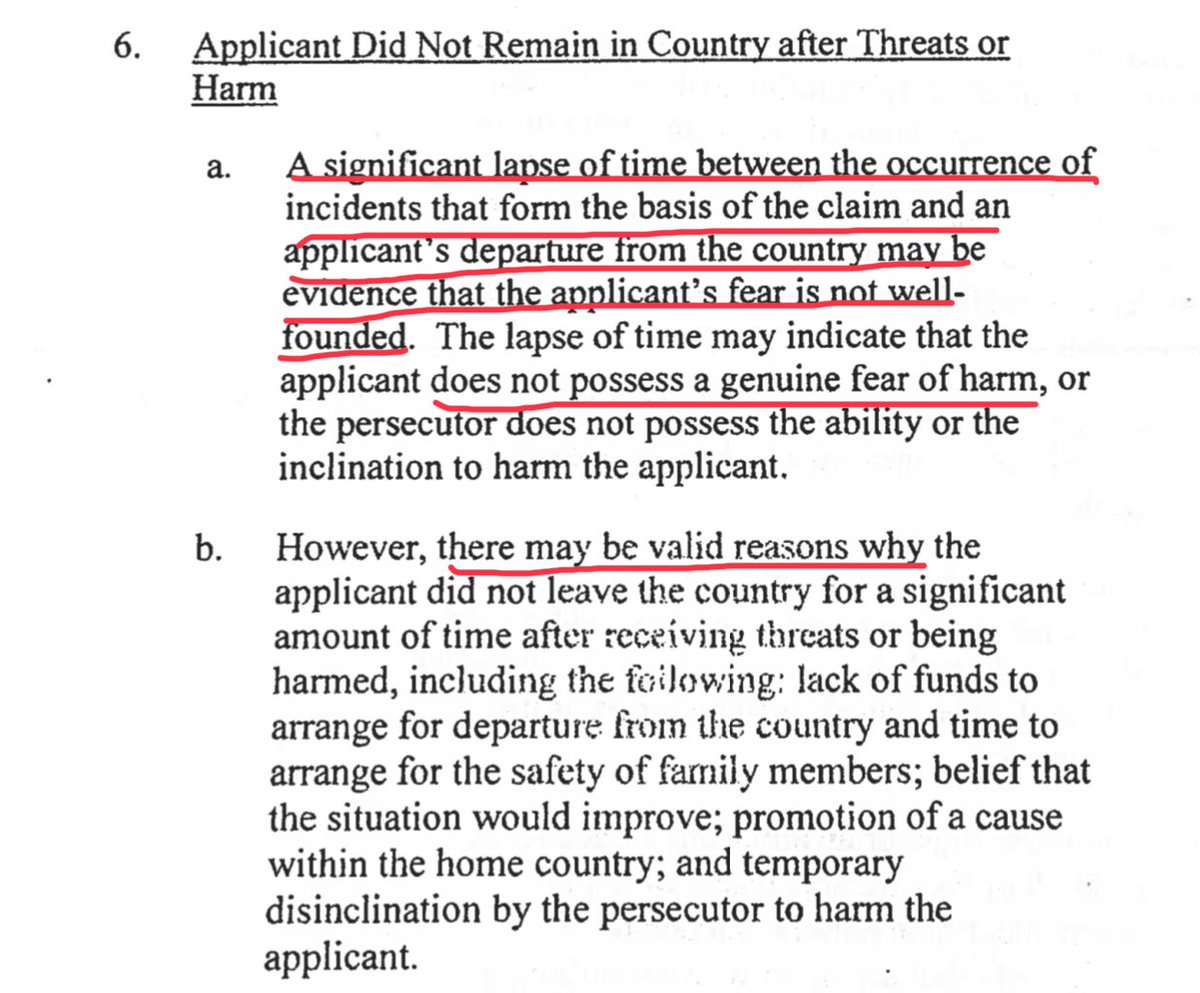
(Oh, sure, it was to try to get one of your siblings out of a gang, and you almost died in the attempt, but still, you went back....)
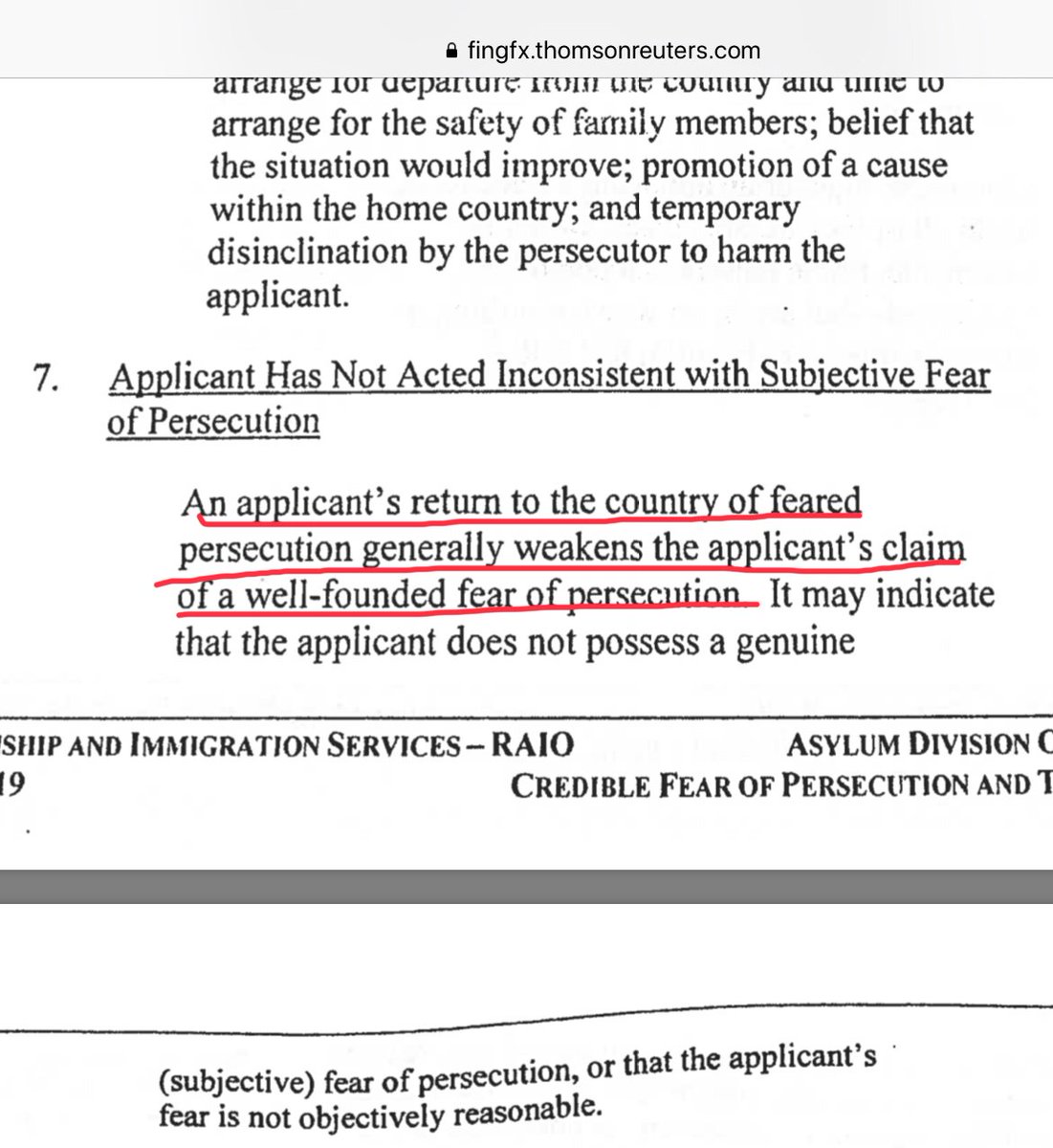
Oh.
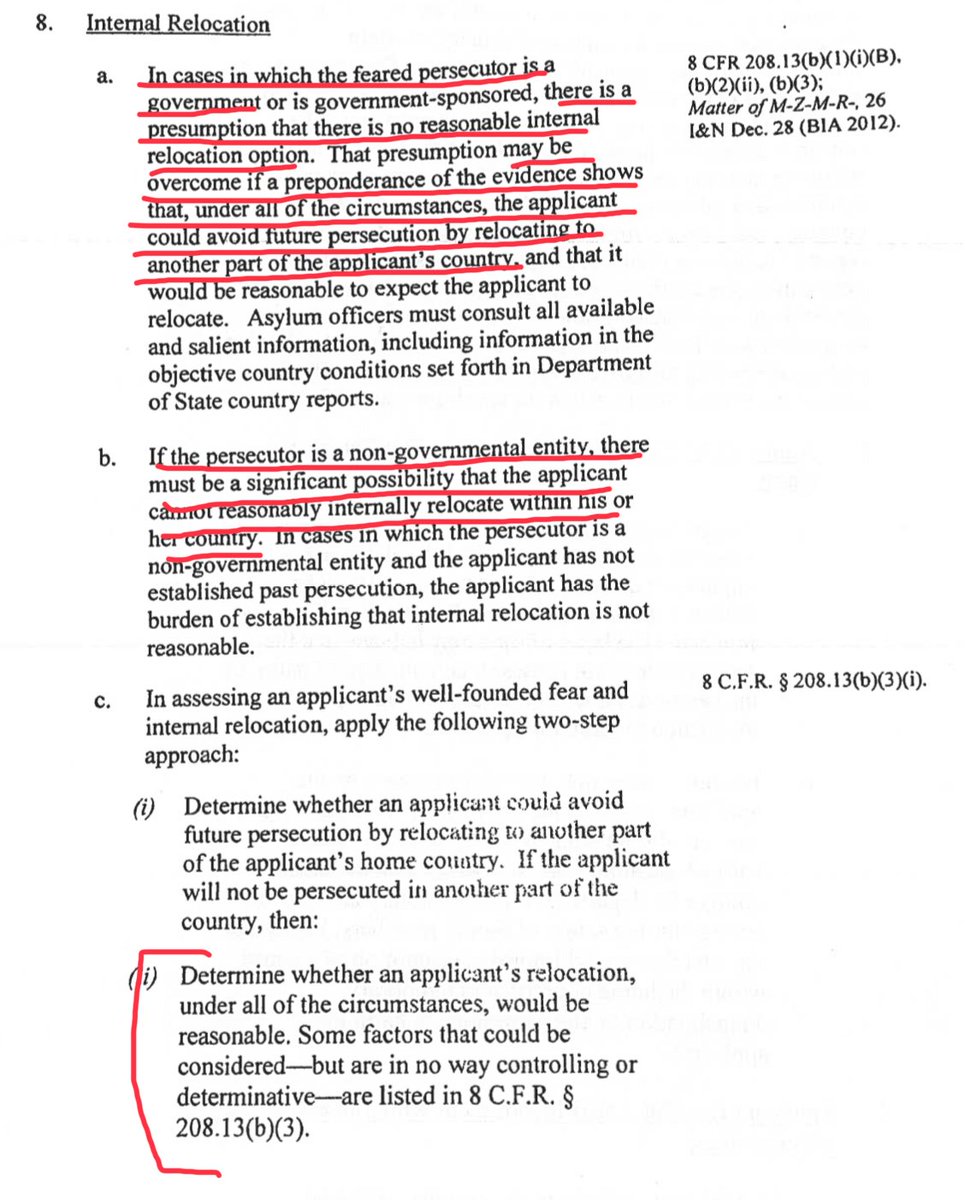
In order to Establish a Well-Founded Fear of Persecution, you-Refugee must be able to prove in a Credible Fear Interview, all of the following:
1) Your fear is "well-founded"--See decimation for details
2) Your persecutor is motivated by your asylum characteristic
4) You left your country promptly after being persecuted
5) And didn't go back
6) And couldn't go back, even somewhere different; really, it's bad...
and finally...
I neglected this one earlier, all excited about Cardoza-Fonseca, but...there is no explanation for what constitutes "sufficiently serious," so your guess is as good as mine.

The big thing about establishing a CF of torture, is that the bar is higher at final hearing, and thus they've raised it here. A refugee has to establish a "more likely than not" standard that they'll be tortured if returned home.

1) pain & suffering
2) that's intentional
3) used to elicit information/confession or to punish/intimidate or for any reason based on discrimination
4) done by the govt or someone on behalf of the govt
I bet #4 stops many claims.
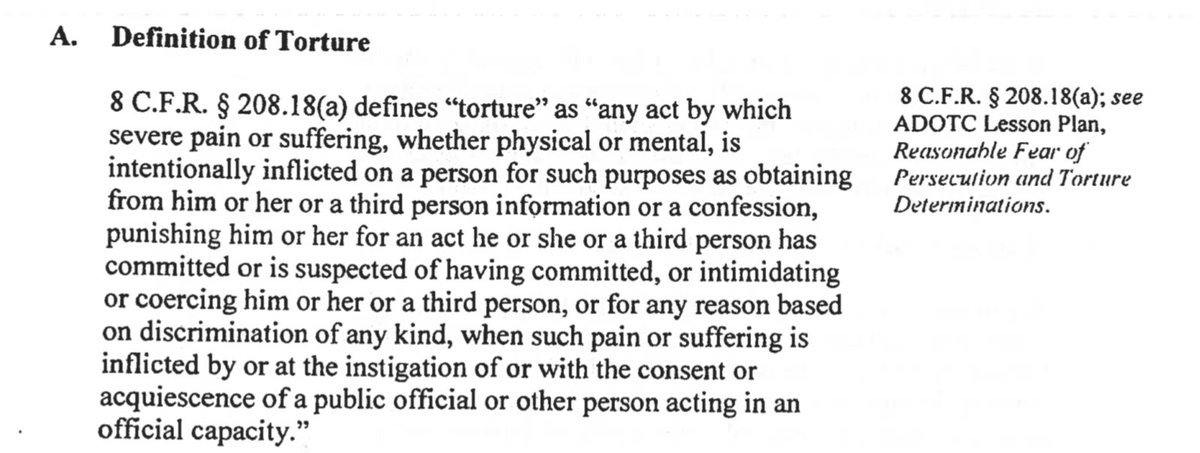
You're still not out of the woods, alas. Cuz they're about to add some qualifiers on those points.
Like, was the pain SEVERE?
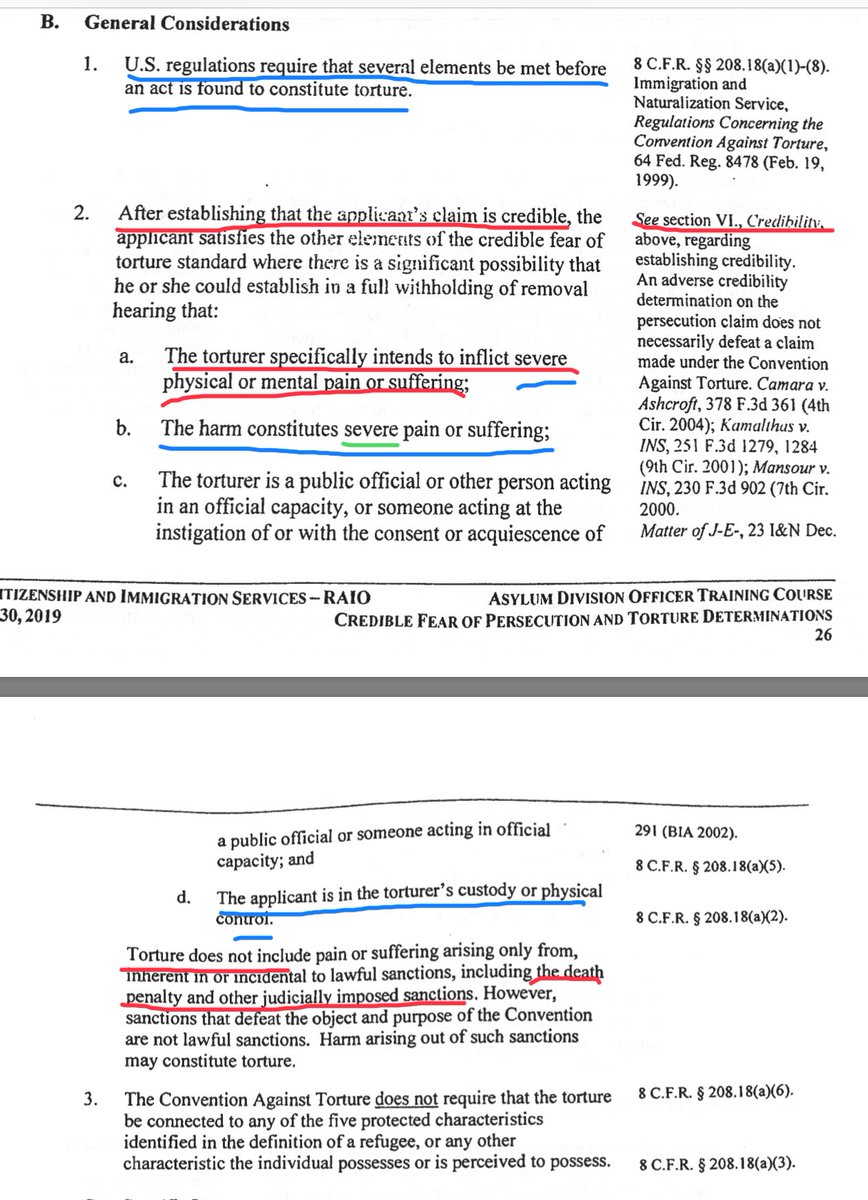
Perhaps one of you has an idea because I am fresh out.
slate.com/news-and-polit…
1) Specific Intent mean that negligence doesn't count, even if it fücked you up bad. They had to WANT to fück you up.
2) Not every little thing is torture. We're not going to tell you what torture is, tho, or even give examples.


4) Torturers better be Officials or they don't count. Seriously. But if your torturer is your boyfriend AND a cop, you are shït out of luck (in blue.)
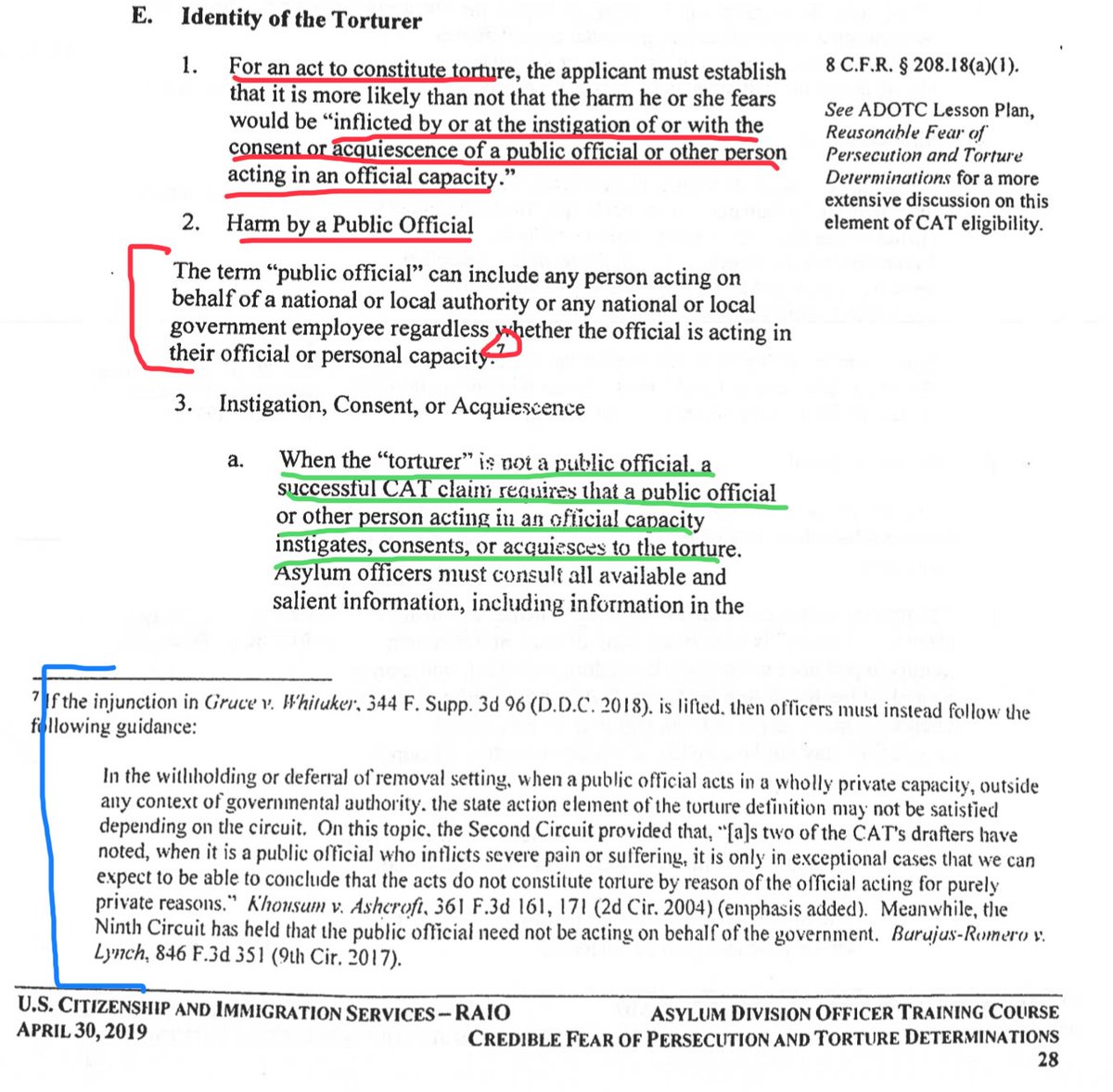
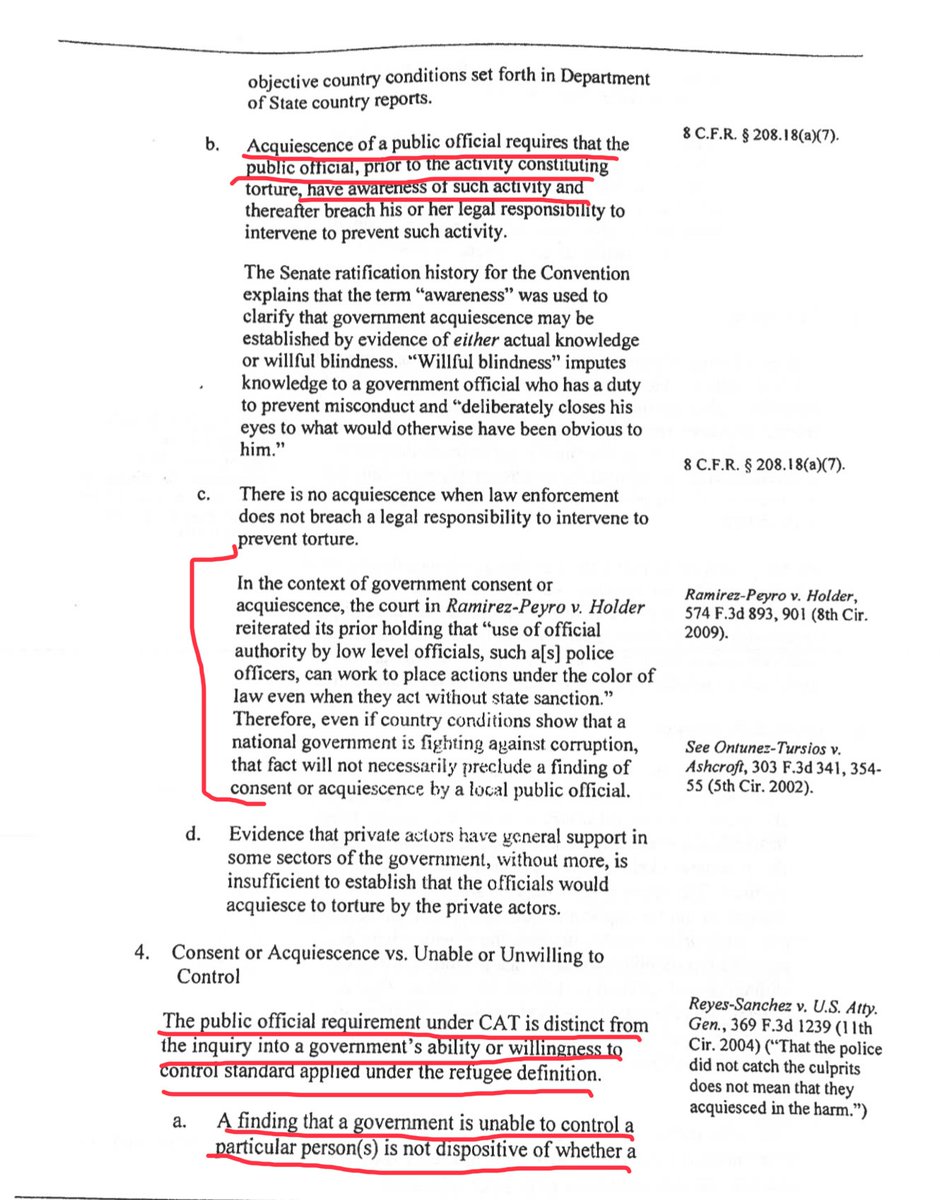

F. Past Harm, wherein in mysterious author argues that someone who has been tortured in the past does not necessarily meet the required threshold for "Credible Fear of Torture," and then one paragraph later says they do.
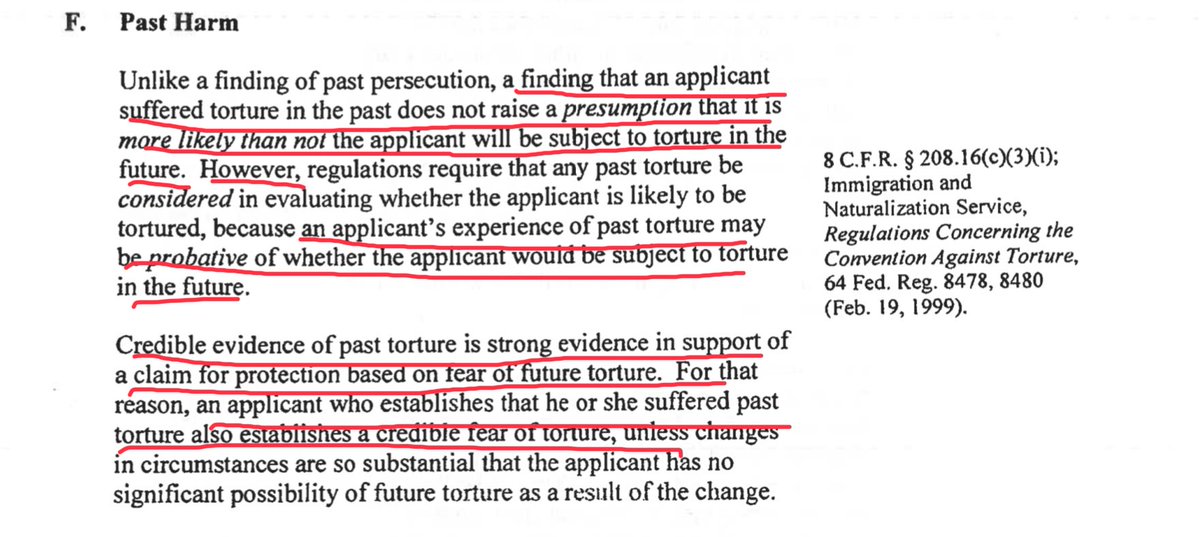
G. Internal Relocation, aka "Can't you just live in the countryside or something?"
Even our odd author realizes this is a ridiculous proposition (in red) after having spent 3 pages making sure the whole country's govt knew who was torturing you and why.
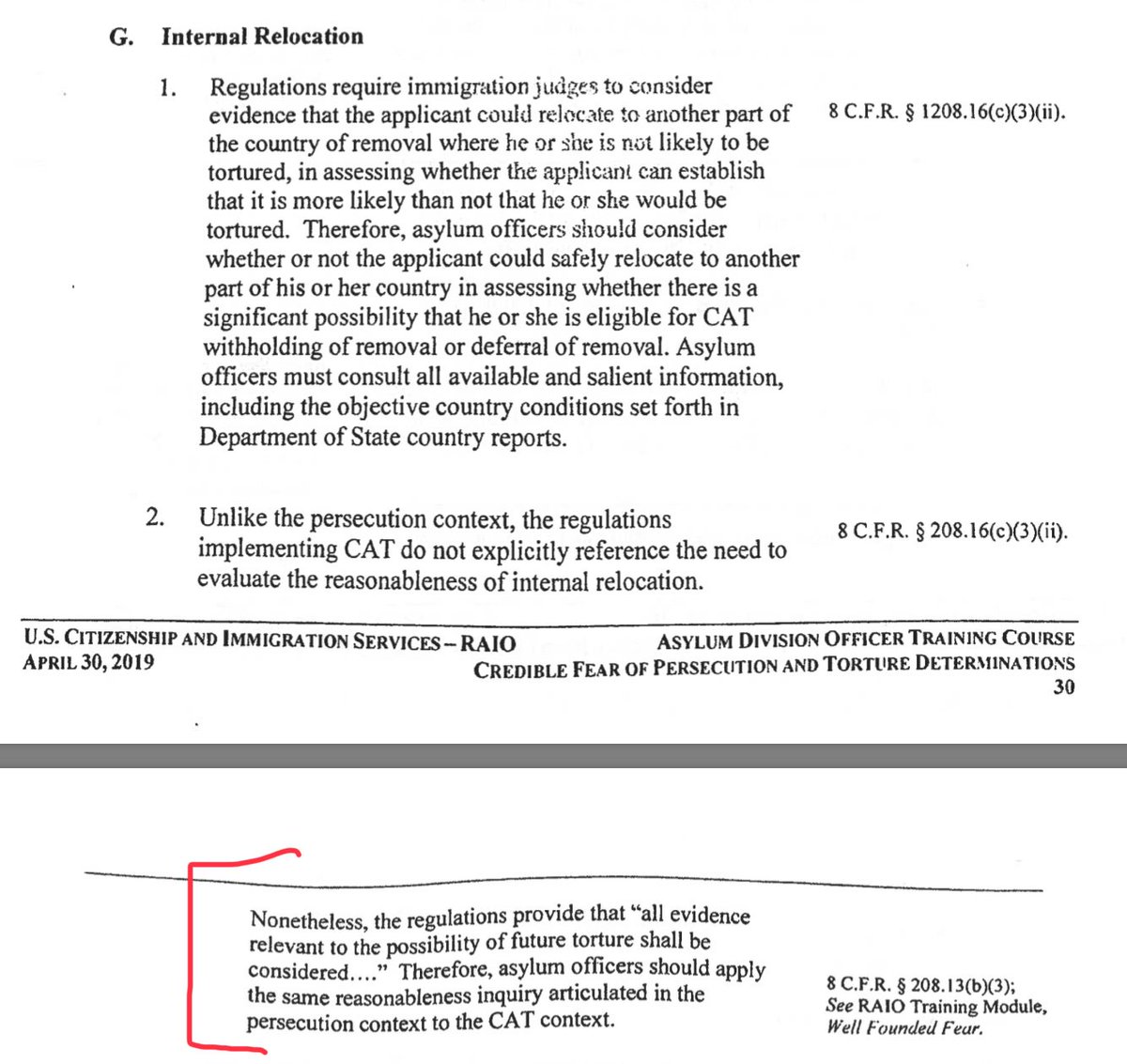
Stuff may come up in the interview that might--EVENTUALLY--bar that person from asylum. These issues have absolutely NO IMPACT on the Credible Fear Interview. But you gotta take notes on em. The immigration judge will want to know.

X - Other Issues
Dependents, like children or spouses, are allowed to be part of a refugee's CFI...unless USCIS for some indiscernible reason says no. Which they can do, apparently. Also, the AO is supposed to ask *each member* of the family,

If I'm a mom who just crawled my way over 1500 miles to get my kids away from a violent hellscape to what I thought was a safe place, just to have us all be arrested, and
The refugee can consult with someone before or during the Credible Fear Interview. This person can be a friend, relative, clergy member, lawyer or representative.
The AO will write up a summary of everything the refugee said, read it back to the refugee,
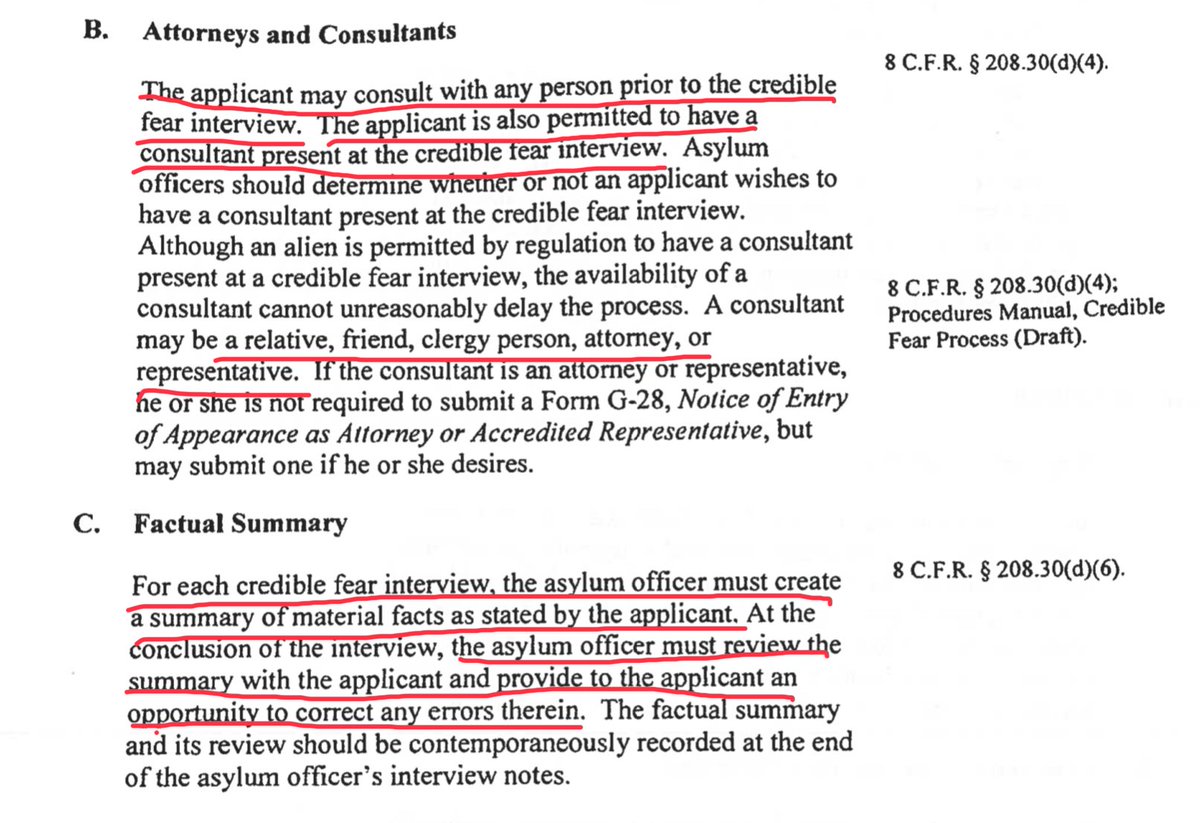
This is a cute one: the Unseen Hand tries to do an end run around the court overturning Session' A-B- decision on domestic violence victims in Central America not being eligible for asylum based on "social group."
"Well, officers can recognize...."

I'm sure it'll be fine. No unintended consequences whatsoever.
fosterglobal.com/blog/five-chil…










